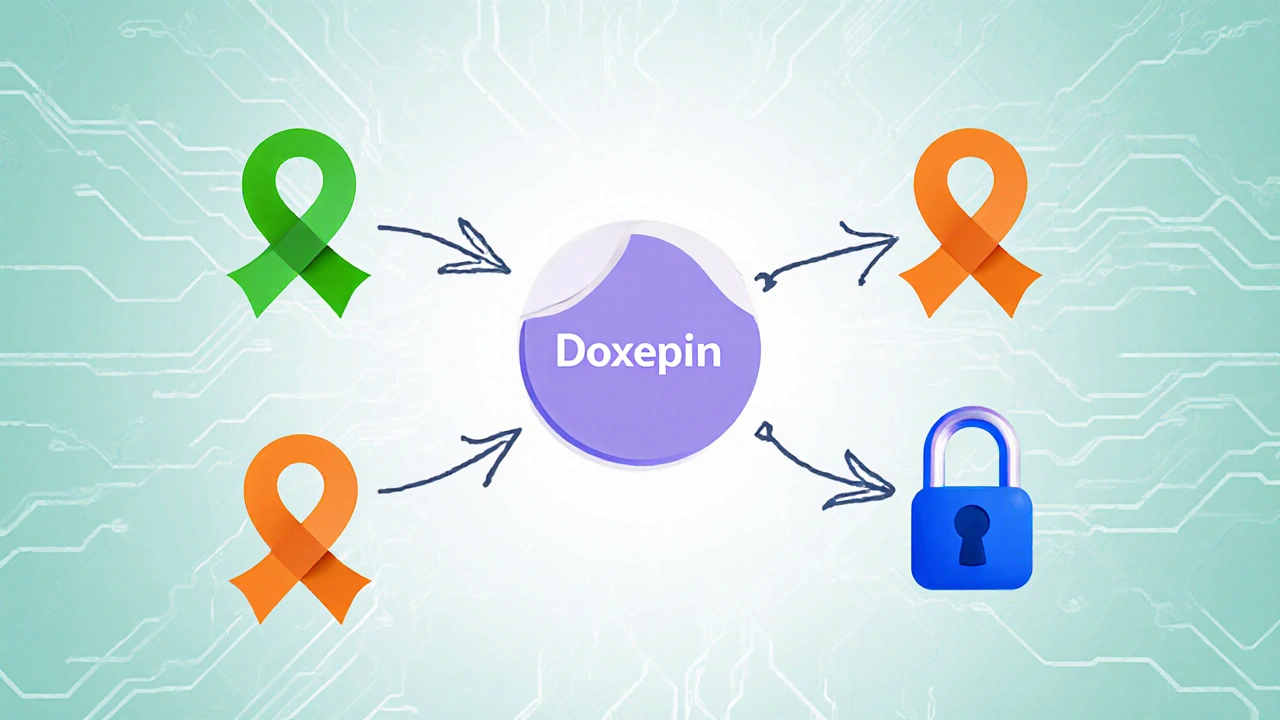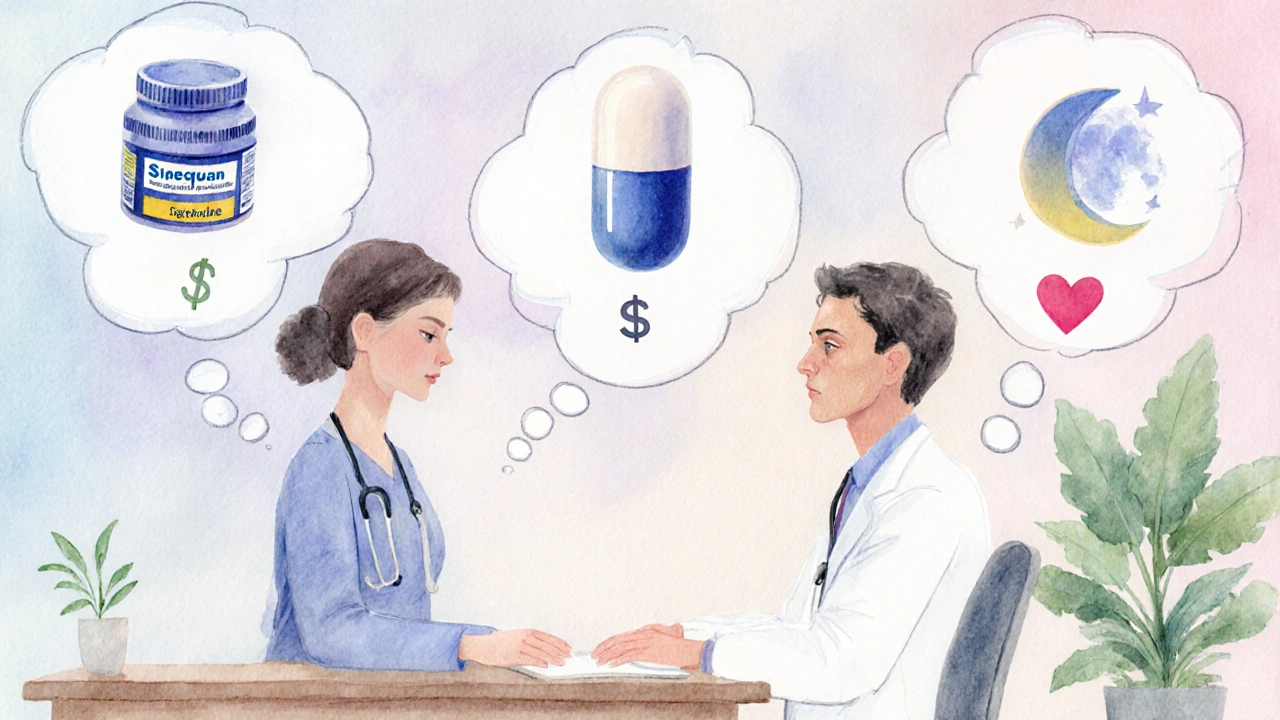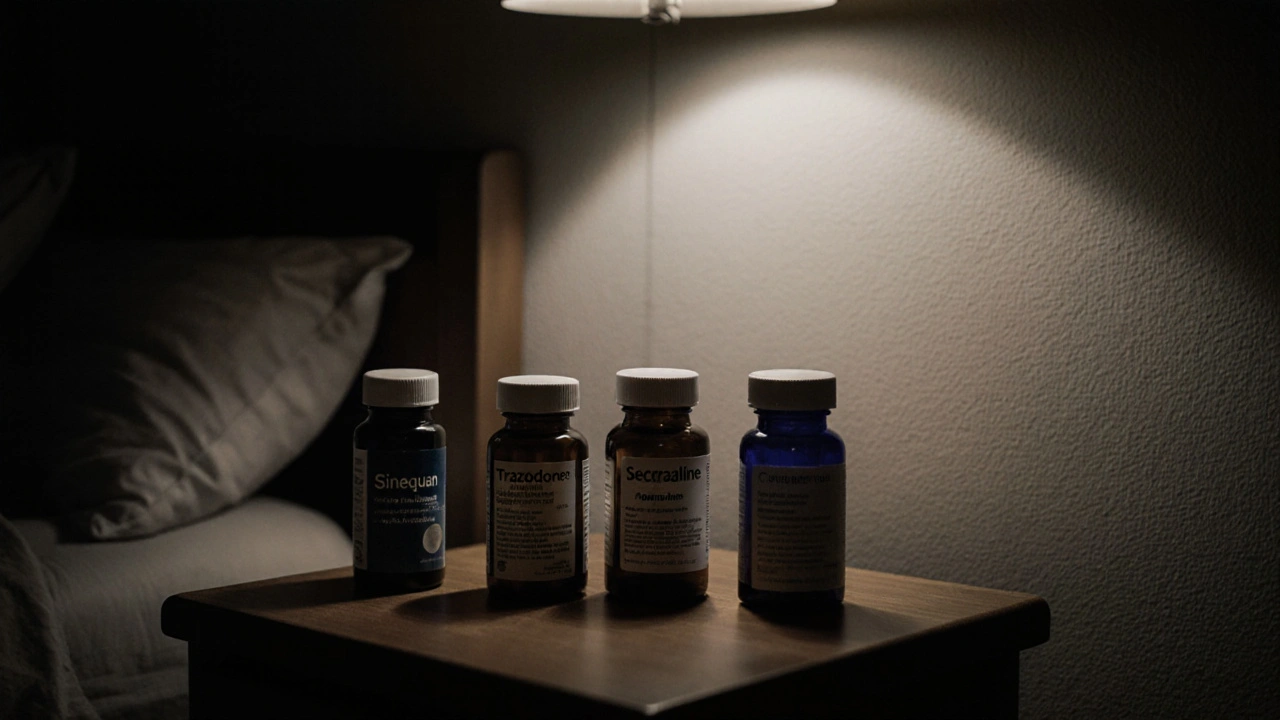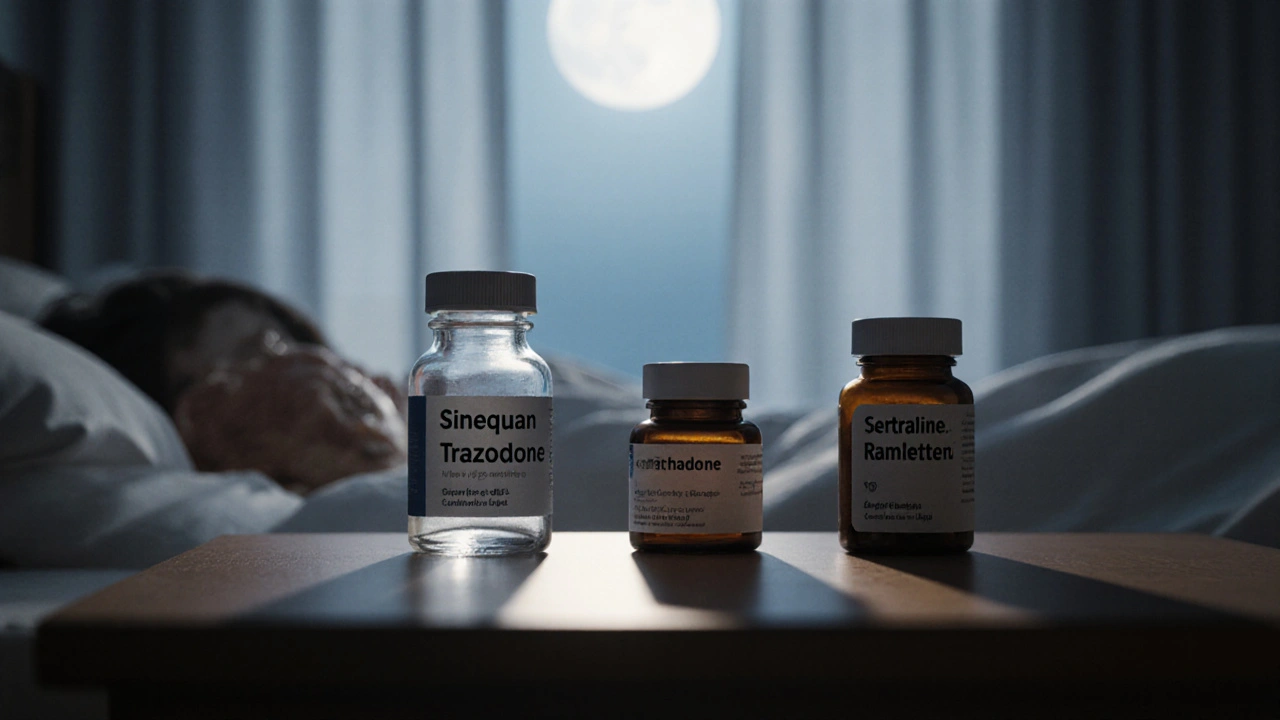Sinequan vs. Sleep Medication Comparison Tool
Recommended Medication:
Enter your symptoms and click "Compare Medications" to see personalized recommendations.
Detailed Comparison:
When doctors prescribe Sinequan (Doxepin), they’re usually tackling either persistent insomnia or chronic depression. If you’re debating whether Sinequan is right for you, you’ll want a side‑by‑side look at the other drugs that can do the same job. Below we break down how Sinequan measures up against the most common alternatives, from other tricyclics to newer sleep‑specific agents.
Key Takeaways
- Sinequan is a low‑dose tricyclic antidepressant that doubles as a sleep aid.
- Alternatives fall into three groups: older tricyclics, modern antidepressants, and dedicated insomnia drugs.
- Side‑effect profiles differ: Sinequan is less sedating than amitriptyline but can cause dry mouth and weight gain.
- Cost varies widely; generic Doxepin is cheap, while newer sleep agents can be pricey.
- Choosing the right drug depends on whether your primary goal is mood improvement, sleep induction, or both.

How Sinequan Works
Sinequan’s active ingredient, Doxepin, belongs to the tricyclic antidepressant (TCA) class. It blocks the reuptake of serotonin and norepinephrine, boosting their levels in the brain. At lower doses (3-6mg) it selectively antagonizes histamine H1 receptors, which explains its potent sleep‑inducing effect without the full antidepressant strength of higher doses.
Because it targets both neurotransmitters and histamine, Sinequan can improve sleep continuity while also lifting mood, making it a unique hybrid option for patients who need both benefits.
Top Alternatives Compared
| Drug | Drug Class | Typical Use | Dosage Range | Onset (hours) | Common Side Effects |
|---|---|---|---|---|---|
| Sinequan | Tricyclic Antidepressant | Insomnia, Depression (low‑dose) | 3-6mg (sleep) / 25-300mg (depression) | 1-2 | Dry mouth, Drowsiness, Weight gain |
| Trazodone | Serotonin Modulator | Sleep aid, Depression | 25-150mg (sleep) | 0.5-1 | Morning grogginess, Orthostatic hypotension |
| Mirtazapine | Noradrenergic & Specific Serotonergic Antidepressant | Depression, Insomnia (off‑label) | 7.5-45mg | 1-2 | Increased appetite, Sedation, Weight gain |
| Amitriptyline | Tricyclic Antidepressant | Depression, Chronic pain, Sleep | 10-150mg | 1-3 | Anticholinergic effects, Cardiac toxicity |
| Sertraline | Selective Serotonin Reuptake Inhibitor (SSRI) | Depression, Anxiety | 25-200mg | 2-4 | Sexual dysfunction, GI upset |
| Ramelteon | Melatonin Receptor Agonist | Sleep onset insomnia | 8mg | 0.5-1 | Daytime drowsiness (rare), Hormonal effects |
| Suvorexant | Orexin Receptor Antagonist | Sleep maintenance insomnia | 5-20mg | 0.5-1 | Sleep paralysis, Next‑day drowsiness |
The table shows that Sinequan’s low‑dose range is far smaller than most alternatives, which often require higher milligram amounts to achieve the same sedative effect. Its dual‑action mechanism gives it an edge for patients who need both mood lift and sleep continuity, but that also means you have to monitor for classic TCA side effects.

When to Choose Sinequan vs. Alternatives
Think of the decision as three questions:
- Is insomnia the primary problem? If you need a pure sleep‑onset agent without antidepressant baggage, ramelteon or suvorexant might be cleaner choices.
- Do you also suffer from depression or anxiety? Low‑dose Sinequan, trazodone, or mirtazapine can hit both targets.
- How sensitive are you to anticholinergic effects? Amitriptyline and higher doses of Sinequan can cause dry mouth, constipation, and heart rhythm changes-sertraline or newer agents avoid those issues.
Patients with a history of cardiac arrhythmia should steer clear of high‑dose TCAs (amitriptyline, Sinequan>50mg) and consider sertraline or a non‑TCA sleep aid instead.
Side Effects & Safety Profile
All drugs carry trade‑offs. Below is a quick safety snapshot:
- Sinequan: Low‑dose sleep use minimizes cardiotoxic risk, but dry mouth and weight gain remain common.
- Trazodone: Can cause orthostatic hypotension and, in rare cases, priapism.
- Mirtazapine: Notable for strong sedation and appetite increase, which can be useful for patients with low weight.
- Amitriptyline: Highest anticholinergic burden; monitor ECG in older adults.
- Sertraline: Generally well‑tolerated; watch for serotonin syndrome if combined with other serotonergic drugs.
- Ramelteon: Minimal side effects, but long‑term safety data beyond 5years is limited.
- Suvorexant: Reports of next‑day sleepiness; avoid alcohol.
Pregnant or breastfeeding patients should discuss alternatives with their provider, as many TCAs cross the placenta.

Cost & Insurance Considerations
Generic Doxepin (the ingredient in Sinequan) typically costs under $10 for a 30‑day supply. Trazodone and amitriptyline are also inexpensive generics. Newer agents like ramelteon and suvorexant often exceed $100 per month, and some insurers place them on higher co‑pay tiers.
If out‑of‑pocket cost is a major factor, starting with a low‑dose TCA or an off‑label trazodone trial can be a pragmatic first step.
Frequently Asked Questions
Can I take Sinequan for sleep without a depression diagnosis?
Yes. Low‑dose Doxepin (3-6mg) is FDA‑approved specifically for insomnia, even in patients without depression.
How does Sinequan differ from regular Doxepin?
Sinequan is the brand name; the chemical is the same. The distinction matters mainly for insurance coverage and brand‑specific formulation.
Is it safe to combine Sinequan with other sleep aids?
Mixing antihistamine‑based sleep drugs (like diphenhydramine) with Sinequan can increase sedation and impair cognition. Always consult a clinician before stacking medications.
What should I monitor if I start a TCA like Sinequan?
Watch for dizziness, dry mouth, constipation, and any heart rhythm irregularities. An initial ECG is advisable for patients over 60 or with cardiac history.
Are there non‑medication options for insomnia that work better than drugs?
Cognitive‑behavioral therapy for insomnia (CBT‑I) has strong evidence and no side effects. Many clinicians start with CBT‑I and add medication only if sleep doesn’t improve after 6-8 weeks.


Stacy Whitman
October 8, 2025 AT 13:40If you think a foreign brand can replace a good old American prescription, you’re dreaming.
Kim and Lin
October 9, 2025 AT 09:06I’m all for the detailed table – it actually helps me compare side‑effects without scrolling forever 😊. The layout is clean, the dosage info is spot‑on, and the quick‑read format makes it easy to decide which med fits my routine.
Kemari Nielson
October 10, 2025 AT 15:40Low‑dose Doxepin’s 3–6 mg range is uniquely small compared with the higher milligram requirements of most alternatives.
Steve Helsel
October 11, 2025 AT 19:26Honestly, this whole side‑effect chart feels like a marketing brochure disguised as medical advice; you could skim it in five seconds and still miss the key risks.
Steve Moody
October 12, 2025 AT 23:13While perusing the comparative matrix, one cannot help but observe the nuanced pharmacodynamic profiles that distinguish a tricyclic from a melatonin receptor agonist; indeed, the heterogeneity of onset times-spanning from 0.5 hours for Ramelteon to 2–4 hours for Sertraline-underscores the necessity of individualized titration, a principle seemingly lost on the lay readership.
Adrian Hernandez
October 14, 2025 AT 03:00Sure, the “nuanced pharmacodynamics” you adore are probably just a smokescreen concocted by big pharma to keep us buying brand‑name pills instead of affordable generics, don’t you think?
duncan hines
October 15, 2025 AT 06:46Yea, the chart looks like a prty hobbyist made it – lots of nice colors but missing the real world stuff like how these meds actually feel after a week of use. Got any real patient stories?
Mina Berens
October 16, 2025 AT 10:33🤔 I’m actually trying to figure out if the weight‑gain side effect of Sinequan will mess with my gym goals. The table mentions it, but does anyone have personal experience on how noticeable it is? Maybe a quick anecdote would help! 🏋️♀️
Chris Meredith
October 17, 2025 AT 14:20From a pharmacokinetic perspective, the low‑dose antihistaminic action of Doxepin provides a selective H1 blockade that translates into minimal sedation beyond the intended sleep window; this is precisely why it outperforms non‑selective antihistamines in maintaining sleep architecture.
Jessie Eerens
October 18, 2025 AT 18:06Indeed, the selective H1 antagonism you describe-while technically impressive-nevertheless fails to address the broader issue of anticholinergic burden that many patients, especially the elderly, cannot ignore; thus, a comprehensive risk‑benefit analysis remains essential.
Caroline Lane
October 19, 2025 AT 21:53Wow, another post hyping old meds-yeah, right.
Geneva Lyra
October 21, 2025 AT 01:40Thanks for breaking down the side‑effects in plain language! It really helps folks who aren’t med‑savvy feel more confident about asking their doctors the right questions.
Moritz Bender
October 22, 2025 AT 05:26Doxepin, marketed as Sinequan, is a low‑dose tricyclic antidepressant that uniquely combines antihistaminic activity with modest serotonin‑norepinephrine reuptake inhibition. At doses of 3–6 mg, the drug preferentially blocks H1 receptors, which accounts for its strong sleep‑promoting effect without the full antidepressant potency seen at higher doses. This dual mechanism makes it particularly valuable for patients who present with comorbid insomnia and mild depressive symptoms. Pharmacokinetically, Doxepin has a half‑life of approximately 15–18 hours, allowing once‑daily dosing that aligns well with bedtime administration. Because the medication is metabolized primarily via CYP2D6 and CYP2C19, clinicians should be mindful of potential drug‑drug interactions, especially with inhibitors of these pathways. In terms of safety, the low‑dose regimen minimizes the classic tricyclic concerns such as cardiac conduction delays, but clinicians still need to monitor for orthostatic hypotension in susceptible individuals. The most common adverse events reported in clinical trials include dry mouth, mild weight gain, and transient daytime sedation, typically resolving after a few weeks of therapy. Compared with older TCAs like amitriptyline, Doxepin’s anticholinergic load is markedly lower, reducing the risk of constipation, urinary retention, and cognitive fog. When juxtaposed with non‑TCAs such as trazodone, Doxepin offers a more predictable onset of action (1–2 hours) and a lower incidence of orthostatic drops in blood pressure. For patients with high anticholinergic sensitivity, agents like sertraline or ramelteon may be preferable, as they lack histaminergic activity altogether. Cost considerations also favor Doxepin; generic versions are typically priced below $10 for a month’s supply, making it a cost‑effective option for many insured and uninsured patients. Insurance formularies often place Sinequan in a lower tier, but prescribers should verify prior authorization requirements, especially when opting for the brand name versus the generic. From a clinical workflow standpoint, initiating low‑dose Doxepin can be done on an outpatient basis without extensive titration, simplifying the prescribing process. However, patient education remains critical: individuals should be instructed to take the medication shortly before bedtime and avoid concomitant CNS depressants to mitigate additive sedation. In summary, low‑dose Doxepin offers a balanced profile of efficacy for sleep maintenance, modest mood improvement, and a tolerable side‑effect spectrum, positioning it as a strong contender among the sleep‑depression pharmacologic toolbox.
Nicole Hernandez
October 23, 2025 AT 09:13Your overview is spot‑on; I especially appreciate the emphasis on patient education and the practical cost notes. It gives clinicians a clear roadmap for when to choose Doxepin over other agents.
florence tobiag
October 24, 2025 AT 13:00While the summary sounds convincing, let’s not forget that any tricyclic, even at low dose, carries a hidden risk of QT prolongation that is often under‑reported in trials; caution is warranted.
Terry Washington
October 25, 2025 AT 16:46Frankly, prescribing a sedating tricyclic to a teenager without exhaustive cardiac screening is nothing short of medical malpractice, and the industry should be held accountable for these reckless practices.
Claire Smith
October 26, 2025 AT 20:33The article fails to address the long‑term neurocognitive implications of chronic low‑dose antihistaminic use.
Émilie Maurice
October 28, 2025 AT 00:20Too many words. Just say: Doxepin works for sleep, watch heart.